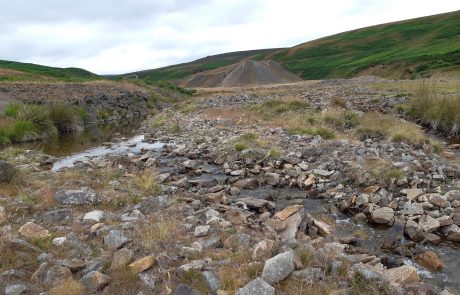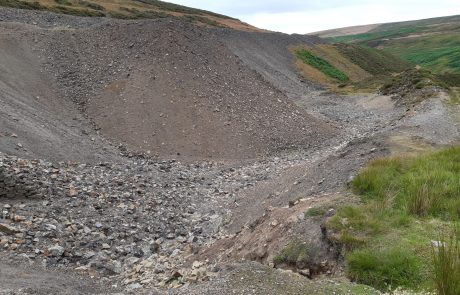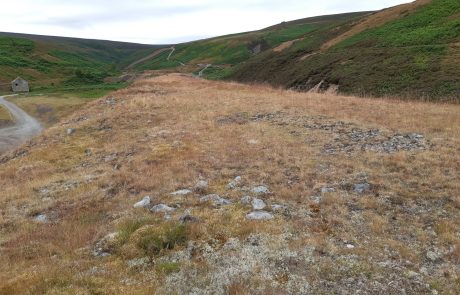News
Reducing pollution from abandoned metal mines
Innovative projects to reduce pollution from abandoned metal mines completed
12 December 2023
- The first phase of two projects to reduce pollution from metal mine waste entering the River Tees has been completed.
- Riverbank walls featuring 900 tonnes of local stone and new grassland will limit metals being washed into the water and provide benefits to the environment.
- Project forms part of ongoing efforts to tackle the polluting legacy caused by generations of mining in the North East and improve water quality.
The first phase of two innovative projects to reduce metal pollution from abandoned lead and zinc mines near Middleton-in-Teesdale has recently been completed.
The new measures, which include building 300m of new riverbank walls and sowing an array of grass and plant species on metal-contaminated land, will limit metals being washed out of mine waste material and polluting Little Eggleshope and Great Eggleshope becks, both tributaries of the River Tees.
While metal mines played a major part in Britain’s history, the abandoned mines and waste they produce can now pollute our rivers and harm aquatic life.
The two projects, with funding totalling £268,000 from the Water and Abandoned Metal Mines (WAMM) programme and The National Lottery Heritage Fund, are helping to improve water quality and restore, expand and connect habitats in the North Pennines National Landscape.
Great Eggleshope
At the former Wire Gill Mine, trial plots of vegetation and grassland have been planted across 0.75 hectares of highly metal-contaminated ore processing wastes.
This means vegetation is now growing over bare mine waste material, which has numerous benefits for the environment, including reducing metals being washed out of the mine waste material by rain, increasing biodiversity through new grassland habitats and capturing carbon dioxide in the soil.
Through these trial plots, the project team is exploring which combinations of vegetation and supportive material could work best for supporting growth on mine waste. Twenty-five different grass, flower and herb species have been sown, alongside a range of different materials such as compost, biochar and rock dust to help the plants grow and withstand different weather conditions.
Little Eggleshope
At the former California Mine, 900 tonnes of local stone has been used to build up 300 metres of riverbank walls to prevent the beck from eroding highly metal-contaminated mine waste material.
In addition to this, 100 metres of drains have been installed to divert rainfall and river water away from the mine waste material. Together, these measures will decrease pollution of Little Eggleshope Beck by reducing the amount of metals like cadmium, lead and zinc that are being washed out of the mine waste material.
Dr Hugh Potter, the Environment Agency’s Water and Abandoned Metal Mine lead, said: “These innovative projects in the North Pennines are already boosting biodiversity and will help to improve water quality in several kilometres of rivers that have been polluted since the 19th Century. These two interventions will help us to achieve the new Environment Act target to halve the length of rivers polluted by abandoned metal mines. Our continuing work, with a range of partners including the North Pennines National Landscape team, is bringing real environmental and economic benefits to the North East.”
Water Minister, Robbie Moore, said: “I am very pleased to see the first phase of this major collaborative project coming to fruition, which will make a vital difference – both environmentally and economically – to the communities in the North Pennines. Through this important programme, we are tackling water pollution caused by historical metal mining, better protecting the natural environment, boosting biodiversity, and improving England’s waterways for generations to come.”
Mandie Kirk, Project Manager at the Coal Authority, added: “This work clearly demonstrates the commitment of the Coal Authority and our partners to improving the water quality of these rivers. We are also undertaking this work in a nature-focussed way, to ensure that the biodiversity of the area can be restored and improved for future generations.”
Tim Longstaff, Project Manager at the Yorkshire Dales River Trust, said: “The River Tees like so many of our rivers has many issues effecting its ecological health. As Rivers Trusts, it has been satisfying to work collaboratively with so many different organisations and individuals to start to tackle the pollution legacy left behind by the abandoned lead mining industry.”
Richard Wearmouth, tenant farmer involved in the project, added: “It has been an interesting project to be part of and I have enjoyed working alongside the various organisations. We started with barren ground and now have natural vegetation coming through, something I found pleasing to be part of.”
The work has been delivered by the Yorkshire Dales Rivers Trust and Tees River Trust and is jointly funded by the Water and Abandoned Metal Mines (WAMM) programme and the North Pennines National Landscape Tees-Swale: Naturally Connected programme.
The Water and Abandoned Metal Mines (WAMM) programme is a partnership between the Environment Agency and Coal Authority to tackle water pollution caused by historical metal mining across England and is funded by Defra.
The Tees-Swale: Naturally Connected programme, led by the North Pennines National Landscape team in collaboration with the Yorkshire Dales National Park Authority, aims to restore, expand and connect habitats and is primarily funded by The National Lottery Heritage Fund.
Media enquiries
Notes for editors
Contact the communications team at the North Pennines National Landscape for further information and alternative images – communications@northpennines.org.uk, phone: Sarah 07768123247 / Kate 07920020648.
About The National Lottery Heritage Fund
As the largest dedicated funder of the UK’s heritage, The National Lottery Heritage Fund’s vision is for heritage to be valued, cared for, and sustained for everyone, now and in the future as set out in our strategic plan, Heritage 2033. Over the next ten years, we aim to invest £3.6billion raised for good causes by National Lottery players to bring about benefits foe people, places, and the natural environment.
We help protect, transform, and share the things from the past that people care about, from popular museums and historic places, our natural environment and fragile species, to the languages and cultural traditions that celebrate who we are. We are passionate about heritage and committed to driving innovation and collaboration to make a positive difference to people’s lives today, while leaving a lasting legacy for future generations to enjoy.
Follow @HeritageFundUK on Twitter, Facebook and Instagram and use #NationalLotteryHeritageFund www.heritagefund.org.uk
Tees-Swale: Naturally Connected The North Pennines National Landscape team and the Yorkshire Dales National Park Authority are working with partner organisations to deliver a major natural heritage programme that focuses on the landscape and communities of Upper Teesdale and Swaledale. Tees-Swale: naturally connected covers 829 square kilometres of Teesdale in the North Pennines National Landscape and Swaledale in the Yorkshire Dales National Park. Inspired by the report ‘Making Space for Nature’, the programme aims to restore, expand, and connect habitats across the uplands of Teesdale and Swaledale, showcasing how public funds can enhance wildlife and deliver multiple public benefits. The ethos of the programme is to work closely and in partnership with farmers, landowners and conservation agencies from the outset. In so doing, we will build the relationships and establish the skills required to sustain our High Nature Value farming systems.










